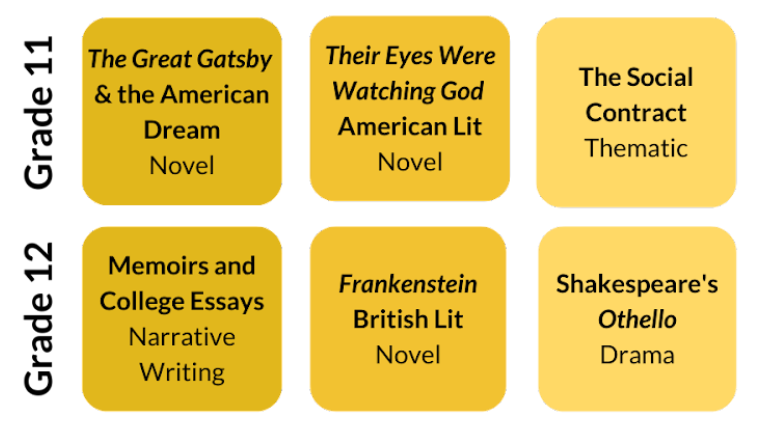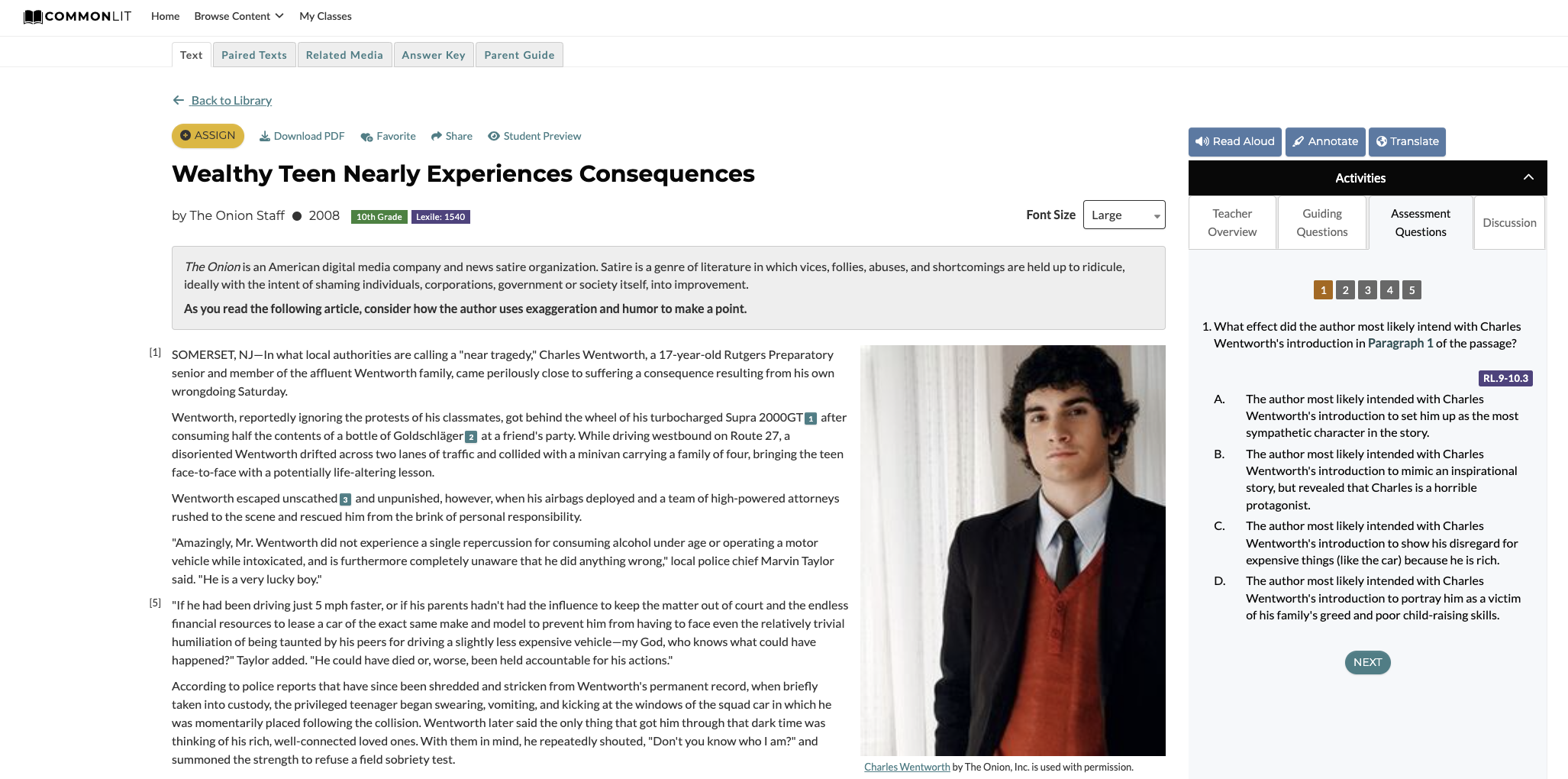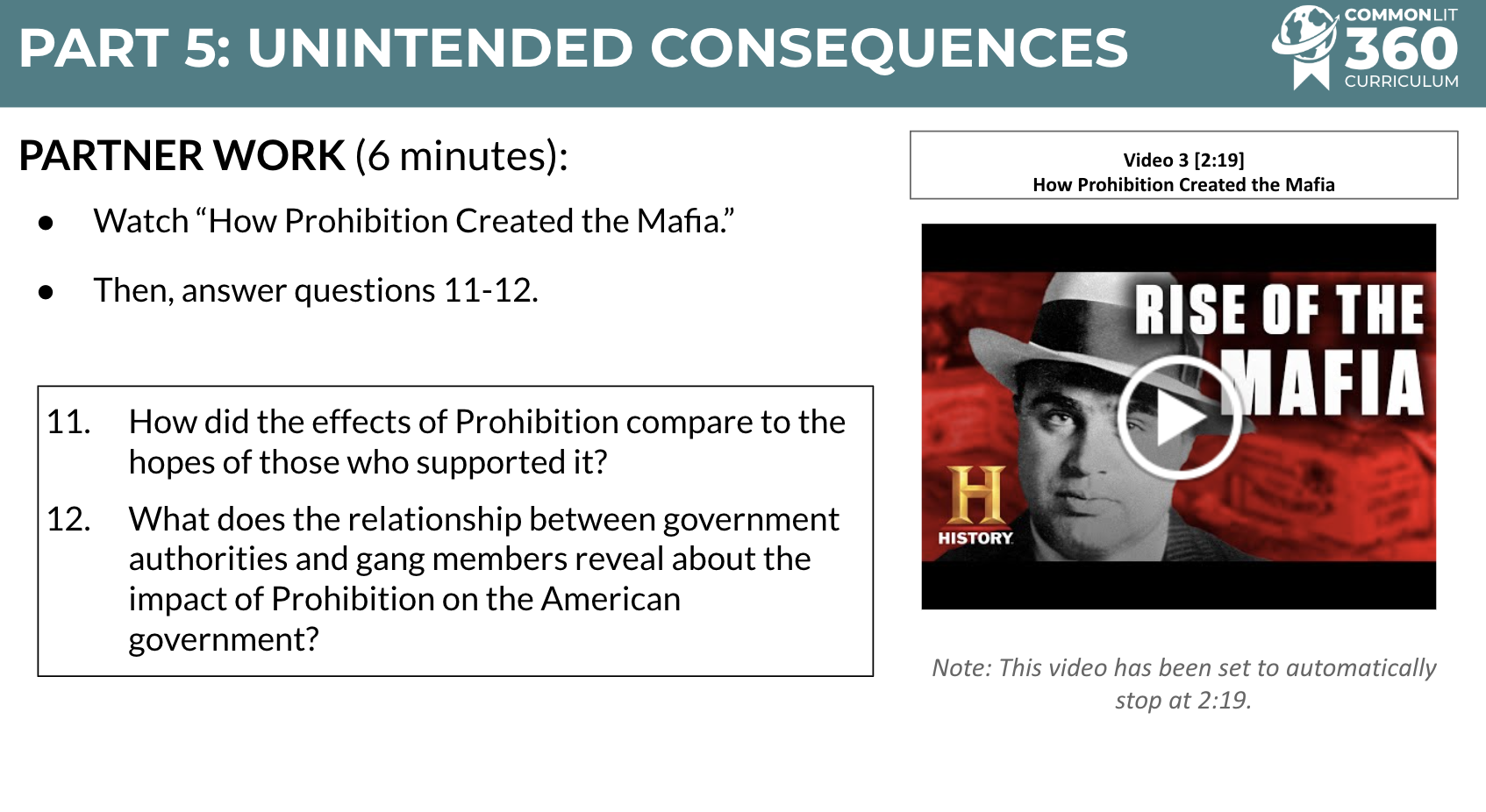 CommonLit 360
The Great Gatsby Novel Study is Ideal for Fostering Reading Comprehension Skills in 11th Grade
CommonLit 360
The Great Gatsby Novel Study is Ideal for Fostering Reading Comprehension Skills in 11th Grade
This unit includes riveting class discussions that will enthrall your students, including conversations about the American Dream as well as a literary analysis on what makes a novel truly “great.”
What Is CommonLit 360?
CommonLit 360 is a free English Language Arts curriculum that includes content-rich units and compelling texts. After seeing so much enthusiasm for CommonLit 360 in grades 6-10, we have started releasing units for 11th and 12th grade. The first unit is available now, with the second and third units being released later in 2022. These units will look a little different from our 6 to 10th grade units because we understand that 11th and 12th grade classes are unique, while including all the parts of CommonLit 360 teachers and students love – meaningful essential questions, highly engaging grade-level texts, and rigorous writing outcomes.
The first unit is a novel study on The Great Gatsby, which will be followed by another novel study for Their Eyes Were Watching God, and then a multi-genre analysis unit.

Why Unit 1 Is Perfect for 11th Grade
The first unit in 11th grade is a novel study featuring canonical text The Great Gatsby by F. Scott Fitzgerald. Unit 1 allows students to immerse themselves into the world of the 1920s as they read a classic American novel and ponder its messages about wealth, dreams, and American society. This unit is perfect for 11th graders because it engages students in thoughtful discussions about wealth and class and gets them excited to talk about literary topics.
Although this text is set a hundred years ago, the unit remains relevant to students by connecting the Roaring Twenties to modern-day America. Students are asked to use their own research and perspectives to compare the two eras. They will gain confidence in voicing their opinions as they craft a literary critique of the novel. Teachers will further engage students by teaching them about thought-provoking and humorous satire, as well as how color is used symbolically to demonstrate how the choices authors make affect reader’s experiences.
The Core Texts in This Unit
This novel study unit is grounded in The Great Gatsby, and supplemented by three other texts to provide meaningful context, perspective, and background knowledge.
- The Great Gatsby by F. Scott Fitzgerald: a dazzling novel that grapples with questions about wealth and social class, love and tragedy, and the status of the American Dream in the Roaring Twenties
- “The Rise of Nativism” by Anne-Marie Reidy: an informational article that explains the historical and social forces that shaped immigration policy in the United States in the 1920s to provide meaningful background knowledge to the text
- “America” by Claude McKay: a poem highlighting a speaker’s internal conflict of frustration and anger towards America’s history of prejudice and discrimination juxtaposed with his emotions of love and awe for his country
- “Wealthy Teen Nearly Experiences Consequences” by The Onion Staff: a piece of satire that highlights the unequal treatment of the wealthy in American society and will jump-start a conversation about wealth and power as well as allow students to understand how satire and irony are used in The Great Gatsby

Unit 1 Drives Student Success
The Essential Questions of this unit are “How has the American Dream evolved over the last hundred years?” and “What makes a novel ‘great?’” These two questions vary in scope, but both provide opportunities for student engagement and self-reflection.
Throughout this unit, students will analyze multiple themes in a text and how they interact and build one one another. They will also examine how authors intentionally relate multiple literary elements and the impact of those choices on readers. Students also analyze satire in The Onion article and The Great Gatsby, navigating the difference between what the text says and what the author actually means.
By the end of the unit, students will write a book review answering the prompt: “The Great Gatsby is one of America’s most revered literary works. It is hailed as ‘the great American novel’ and taught in nearly every high school in the country. Is this reverence deserved? In your opinion, is The Great Gatsby truly great?” Book reviews are a new genre of writing for students, and allows students to express their personal evaluation of the novel while grounding their argument in literary analysis. These skills will help students thrive in 11th grade.
Throughout the unit, students are empowered to express their personal evaluation of the novel grounded in literary analysis. Writing lessons teach students how to use relatable comparisons and build credibility with personal details. As a former teacher, I know how difficult teaching writing can be. Luckily, CommonLit’s writing lessons are scaffolded and rigorous, with a clear scope and sequence that will set students up for success by the end of the unit. Writing lessons give students exemplar essays to use as examples, and help students plan their book review, revise their writing using relatable comparisons, and building credibility with personal details.
Students also can engage with an optional essay in which they argue whether Fitzgerald’s societal critique is still relevant today. This essay helps students practice key writing skills, including synthesizing relevant information from their research to make an argument about themes in The Great Gatsby. Synthesis is a key skill for 11th graders that will be critical to students' success in high school and beyond.
The Related Media Exploration will allow students to fully immerse themselves in the world of the Roaring Twenties. Students will learn how new industries and Prohibition shaped American society in the 1920s. Towards the end of the unit, students will discuss Fitzgerald’s critiques of 1920s America and conduct independent research into how one aspect of American society has evolved to the present day.

Students can reflect on their experience living through the COVID-19 pandemic with the influenza pandemic during the Gatsby era. They will enjoy reading “100 years ago: An election, a virus and a cry from disillusioned youths,” which highlights the surprising similarities and differences between the world of the 1920s and the 2020s.
Another exciting theme discussed in the unit is how Fitzgerald utilizes color symbolism to effect meaning. Students discuss color symbolism in everyday life and in The Great Gatsby. Students are also assigned a color to track throughout the entire novel, taking notes every time their color is mentioned in the novel. This engaging tracking tactic will allow students to truly understand color symbolism in this text and beyond.

Unit 1 Drives Teacher Success
The chapter guides used for During Reading provide students with glossaries of allusions and cultural references, vocabulary words, annotation guides, close reading instructions, and discussion prompts. The teacher Chapter Overviews provide educators with summaries, reminders of prompts and skill focuses, lesson activities and pacing recommendations, and exemplar answers to close reading and discussion questions. These fully built out guides save essential time when lesson planning.

CommonLit 360 provides a wealth of tools that will make lesson planning a breeze. Each comprehensive unit is set up for teachers and includes everything from fully-fleshed out lesson plans to vocabulary quizzes to discussion prompts and more. If your school purchases our School Essentials PRO package, you can access our Professional Development Portal. These self-paced tutorials are specifically designed to help teachers utilize all CommonLit 360 has to offer in their classroom.
Additionally, digital grading and feedback tools, interactive reading and writing lessons, and data tracking can save you hours previously spent on planning and grading. Working within contract hours will no longer be an unattainable pipe dream, and you can use the extra time to continue to focus on relationship building in your classroom.
Next Steps
Sign up for a CommonLit 360 webinar to get a comprehensive overview of how the curriculum works and how to use the digital platform.
Interested in gaining access to live and on-demand professional development that will help your team take full advantage of CommonLit 360?

